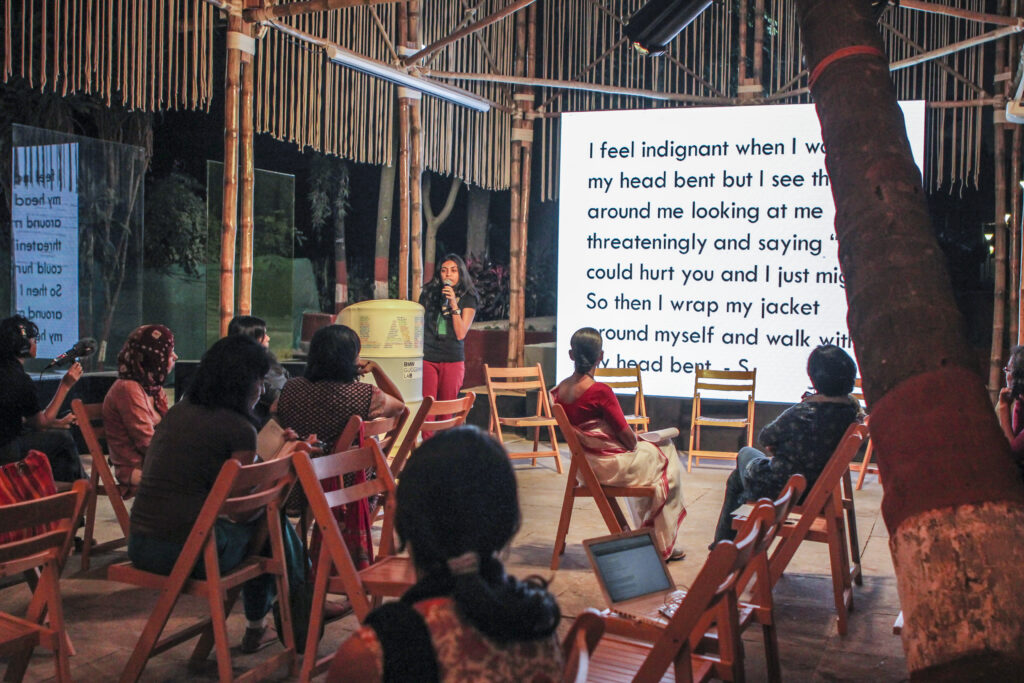
Over the last ten years, the book Why Loiter? Women and Risk on Mumbai Streets (2011) has traveled with me across institutional spaces from Ahmedabad to Ann Arbor and Detroit to Calicut, whilst also guiding me to model the authors’ call for courting risk on a personal level: my own loiterings against academic patriarchy within and beyond those very spaces as a queer feminist.
In this reflection, it is difficult for me to trace back the story of how I found the book to a single origin point. Interested in feminist discourse on cities, I recall reading about the Gender and Space project by Shilpa Phadke, Sameera Khan, and Shilpa Ranade first on the website of Partners for Urban Knowledge, Action, and Research (PUKAR) in early 2011. Whilst still in Michigan, I was building a reading list in preparation for my summer teaching fellowship at CEPT University in Ahmedabad that same year. Prior to receiving a book copy, I had marked a set of corresponding pieces by the authors, including “Bombay Girl, Interrupted” (with Khan 2011), “Why Loiter? Radical Possibilities for Gendered Dissent” (Phadke 2009), and “The Way She Moves: Mapping the Everyday Production of Gender Space” (Ranade 2007) as part of my bibliography. Additionally, having watched Paromita Vohra’s film Q2P (2006) at a previous campus event and already included it as course material, I found Why Loiter? as a core and complementary text for my summer teaching; a text that was pertinent to understanding the politics and production of feminist urban research in India more broadly.
Personally, the 2011 summer fellowship was a deeply generative experience for me as it marked the start of my friendship with architect-researcher Shilpa Ranade. Being on a School of Architecture teaching fellowship on CEPT campus at the same time, our worlds connected at various events then and subsequently, starting with co-reviewing at the 2011 thesis works in urban design and followed by her guest engagements in my graduate and undergraduate teaching—face to face, online, and remotely. During this time, I was connected with Shilpa Phadke and Sameera Khan around my review of their book, which appeared in the May 2013 issue of EDRA (Environmental Design Research Association) Connections.
Since then, I have utilized the framework and findings of Why Loiter to explain the arts and activist initiatives of Bangalore-based Blank Noise Collective for PAGE and Imagining America: Artists and Scholars in Public Life as well as guide students in architecture and interdisciplinary humanities to further feminist inquiries into urban infrastructures at both structural and experiential levels. See, for example: “The Dialectics Of Feminist Counternarratives And Direct Public Engagement: Towards An Everyday Praxis in response to the fellowship application question: How can we achieve a productive synthesis between our practices of cultural critique and counternarratives, and other, directly participatory and hopeful ways of engaging? See also: my Twitter shout-out to Ashya Suresh’s brilliant and recently concluded B.Arch thesis at Avani Institute of Design, which investigated the role of architecture in mitigating the compounded experiences of exclusion, disadvantage, and even violence that bodies outside social defaults of gender, sexuality, caste, class, age, and ability face on a daily basis in Kerala’s public road transportation systems (KSTRC). To this day, I prescribe Why Loiter? alongside the writings of Ananya Roy, Ayona Datta, Deborah L. Parsons, Gautam Bhan, Iris Marion Young, Petra L. Doan, and Renu Desai in my teaching and public discussions on gender and the city.
Circling back to the book’s networked origins and role in inspiring interdependent new worlds, I would be remiss if I didn’t conclude this post with a note of gratitude to all three authors for inviting me to moderate “Freedom from Protection: Women and the Right to Risk in the City” panel at Bangalore International Center (BIC) last month. The video of this conversation, which took place on March 5, 2021 can now be accessed on BIC’s YouTube channel. Thank you Lekha Naidu, Prem Chadavarkar, Ravi, and Raghu for your program coordination, event publicity, and generosity. Thank you and hearty congratulations to #WhyLoiterAtTen
Image: Women and Social Spaces, BMW Guggenheim Lab Mumbai, December 2012 that was first used and filed under recent work on my WordPress.com blog (2010-2016) (Source: http://www.flickr.com/photos/bmwguggenheimlab). Follow #WhyLoiterAtTen on Twitter to learn more about the book and its life among feminist readers and fellow loiterers.